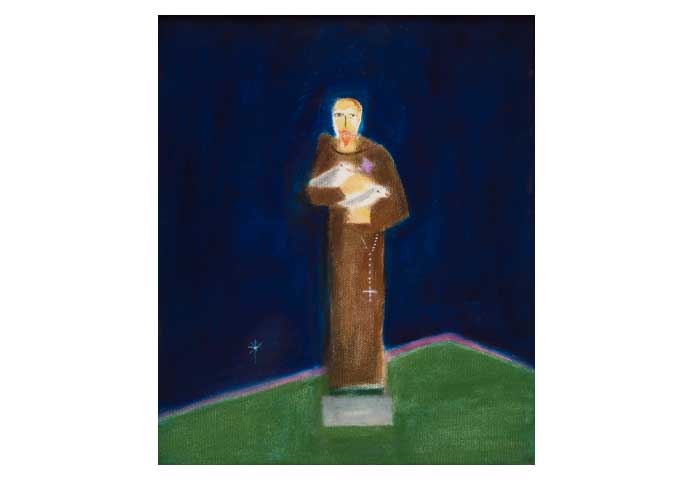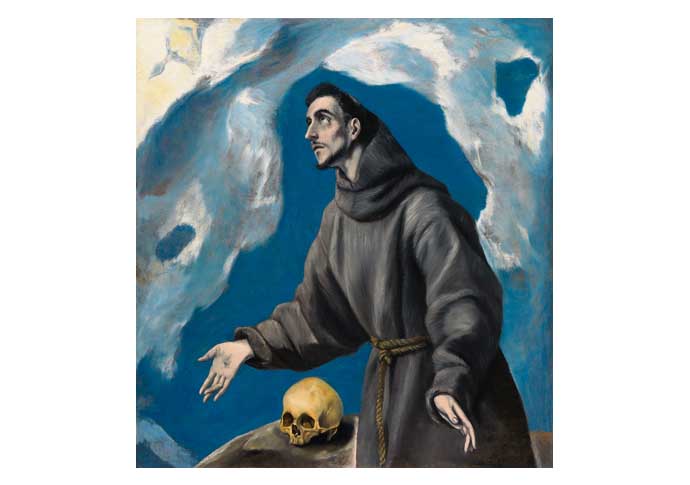Saint ecology!
The popularity of St Francis of Assisi knows no bounds, as John Evans sees
Thursday, 11th May 2023 — By John Evans

Craigie Aitchison, Saint Francis, 1993, oil on canvas, 30.5×25.5cm, Jerwood Collection [© Jerwood Collection / Bridgeman Images]
WHEN he decided on his new chosen name Jorge Mario Bergoglio went for one none of his predecessors had, but one he said reflected his own concerns for the state of the world and the importance of dealing with its poverty.
So it came about that in 2013 Pope Francis gave a 21st-century boost to one of the most popular saints in history. The recognition for
St Francis of Assisi, who died in 1226 aged about 44, is not new. The experts behind a new, free, exhibition at the National Gallery describe the saint as “one of history’s most inspirational and revered figures”, and “probably the most represented saint in the history of art …”
As the popularity of the Franciscan movement grew, so did the imagery surrounding its founder.
“Art historians have estimated that as many as 20,000 images of Francis, not even including those in illuminated manuscripts, might have been made just in the century after his death,” the gallery says.
Here the National’s director Dr Gabriele Finaldi and co-curator Dr Joost Joustra, have chosen more than 40 artworks and artefacts relating to the saint from European and American collections, both public and private. They have also, with other contributors, authored a comprehensive catalogue to accompany the exhibition, which spans nine centuries.

El Greco, Saint Francis Receiving the Stigmata 1590-95, oil on canvas, 114x104cm, National Gallery of Ireland, Dublin [Photo © The National Gallery of Ireland]
Highlights include exceptional images from the gallery’s own collection, notably Francisco de Zurbarán’s oil, Saint Francis in Meditation from 1635-39, and Sandro Botticelli’s tempera and oil on wood, Saint Francis of Assisi with Angels from about 1475-80.
And there are seven panels, from about 60 originally painted, for the San Sepolcro altarpiece, from 1437-44, by Sassetta (Stefano di Giovanni).
Images of Francis, this son of a prosperous merchant who would go on to found an order of friars, a women’s order and a lay order, and to lead the movement of evangelical poverty, are many a varied.
And this is well reflected in the exhibition.
Magnificent loans explore the element of mysticism surrounding Francis, with highlights including El Greco’s Saint Francis Receiving the Stigmata, 1590-95, from the National Gallery of Ireland, Caravaggio’s Saint Francis of Assisi in Ecstasy, about 1595, from Wadsworth Atheneum Museum of Art, Connecticut, and Bartolomé Esteban Murillo’s anachronistic Saint Francis embracing the Crucified Christ, 1668-69, from Seville’s Museo de Bellas Artes.

Bartolomé Esteban Murillo, Saint Francis embracing the Crucified Christ, 1668-69, oil on canvas, 291x191cm, Museo de Bellas Artes, Sevilla [© Museo de Bellas Artes de Sevilla]
Notwithstanding myths and legends it’s this man’s legacy that is enduring.
When Pope John Paul II declared Francis the patron saint of ecology in 1979 and much later referred to him as “The poor man of Assisi”, this was for contemporary audiences.
Of course, he wasn’t a poor man at all, rather one who embraced poverty as a lifestyle yet retained great influence, and was canonised just two years after his death.
So the simple habit and the rope belt, so often central to depictions of the saint, remain important, as do the accompanying stories; whether of preaching to the birds or persuading the wolf not to eat more people in the town of Gubbio in Perugia.
In this context some later works in the show are of interest.
A series of lithographs from Arthur Boyd, from 1965, include the saint being beaten by his father; and even St Francis with a brothers preaching naked!
Sir Antony Gormley’s sculpture Untitled (for Francis), 1985, in the opening room, has the stigmata prominent. Sir Stanley Spencer’s St Francis and the Birds, 1935, is based on a view of his father feeding ducks, and was one of two paintings rejected at the Royal Academy’s summer exhibition which led to Spencer’s resignation as an RA.
Then if not devotional, certainly simple and beautiful, there’s Craigie Aitchison’s 1999 oil, Saint Francis, from a small statue he had of the saint with a view of Goat Fell on the Isle of Arran where the artist spent time and a child.
• St Francis of Assisi, at the National Gallery, WC2N 5DN until July 30.
www.nationalgallery.org.uk